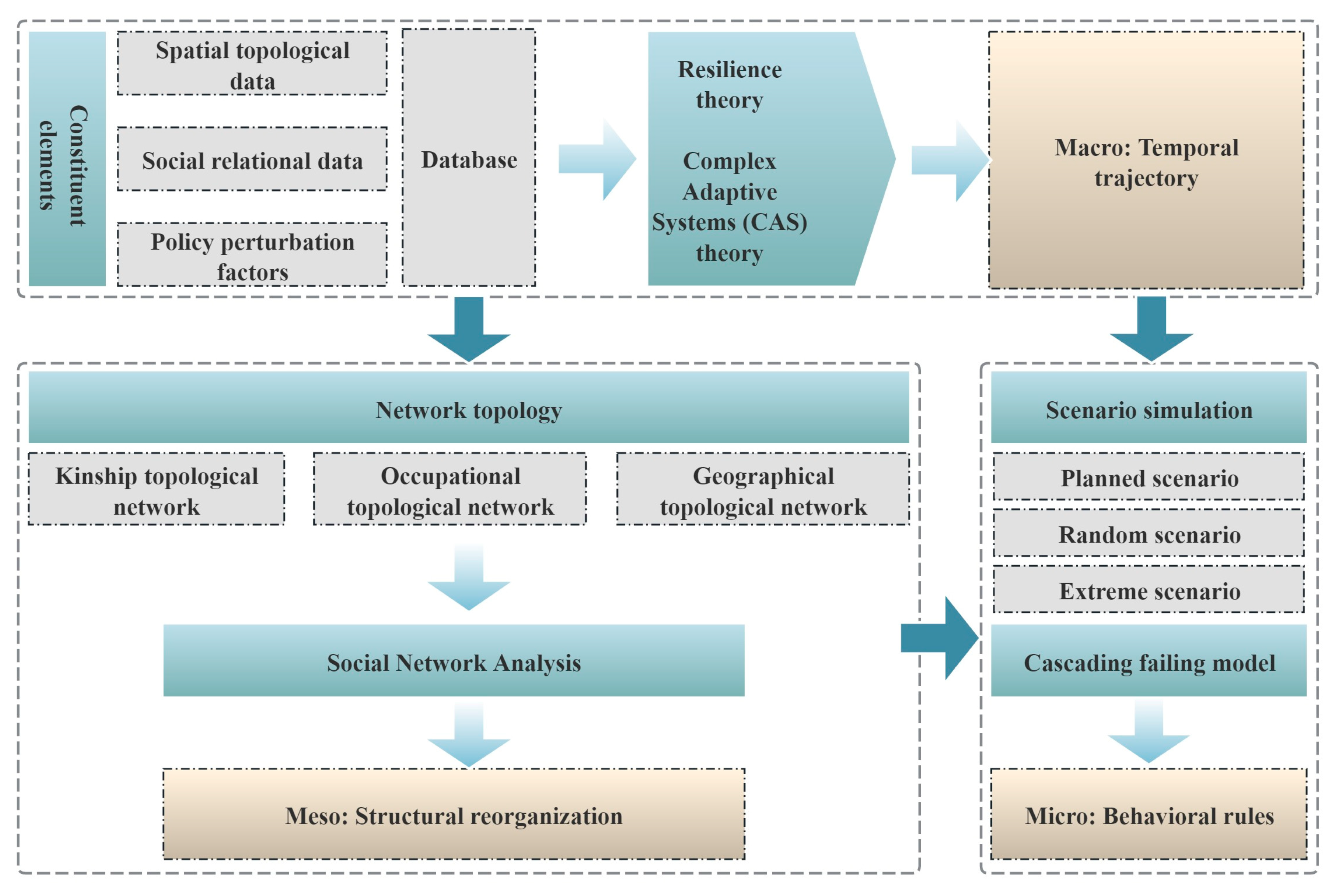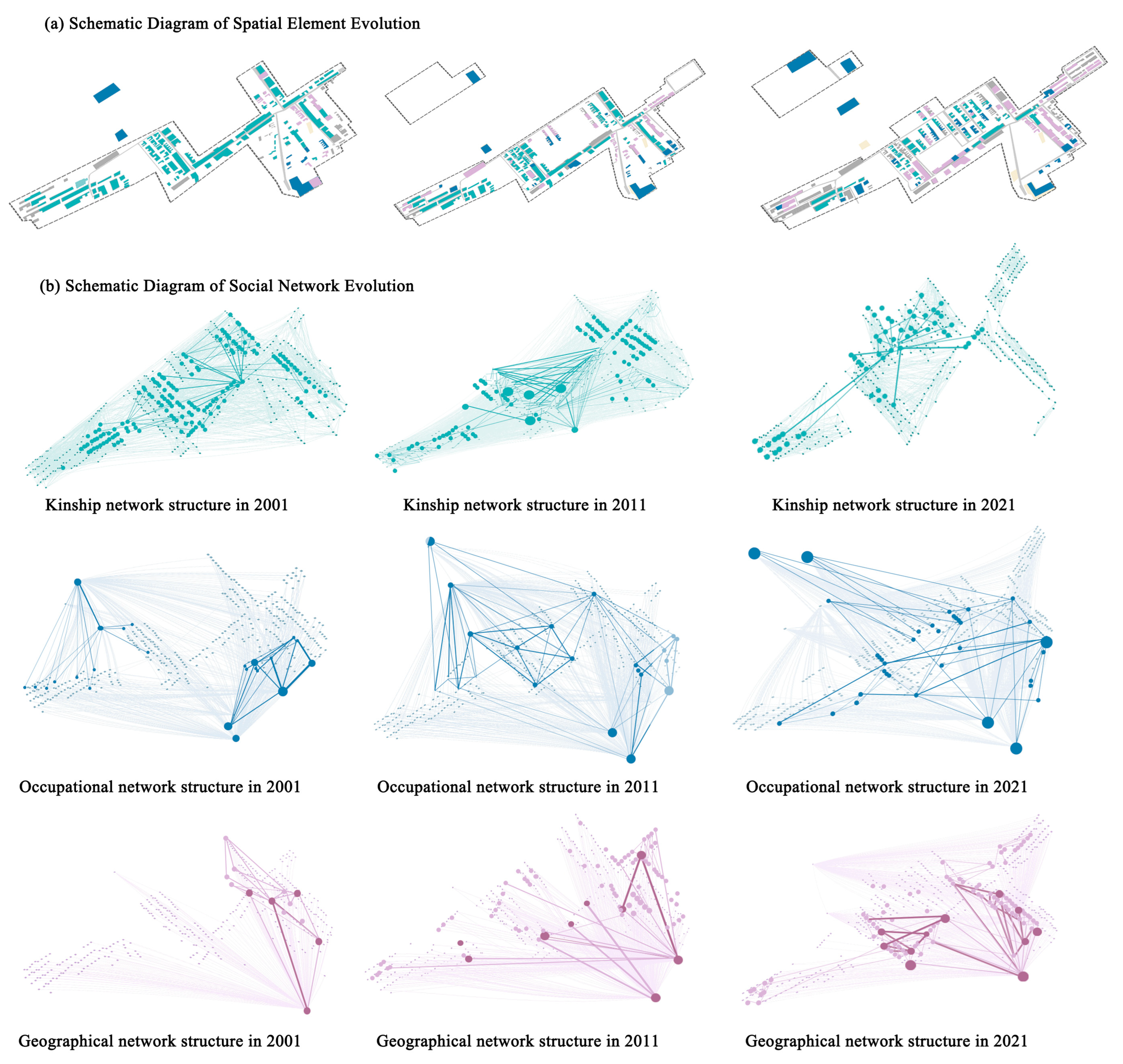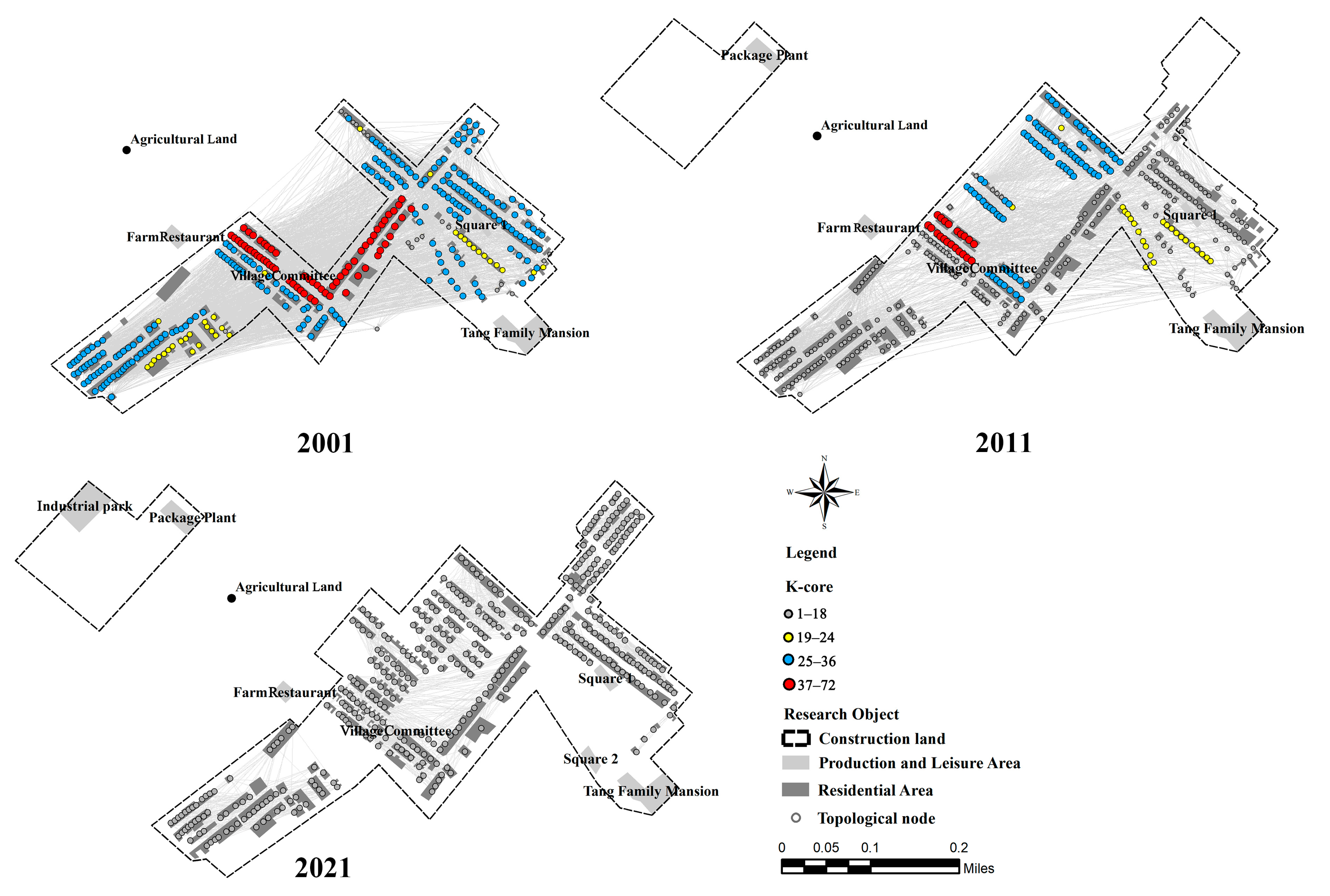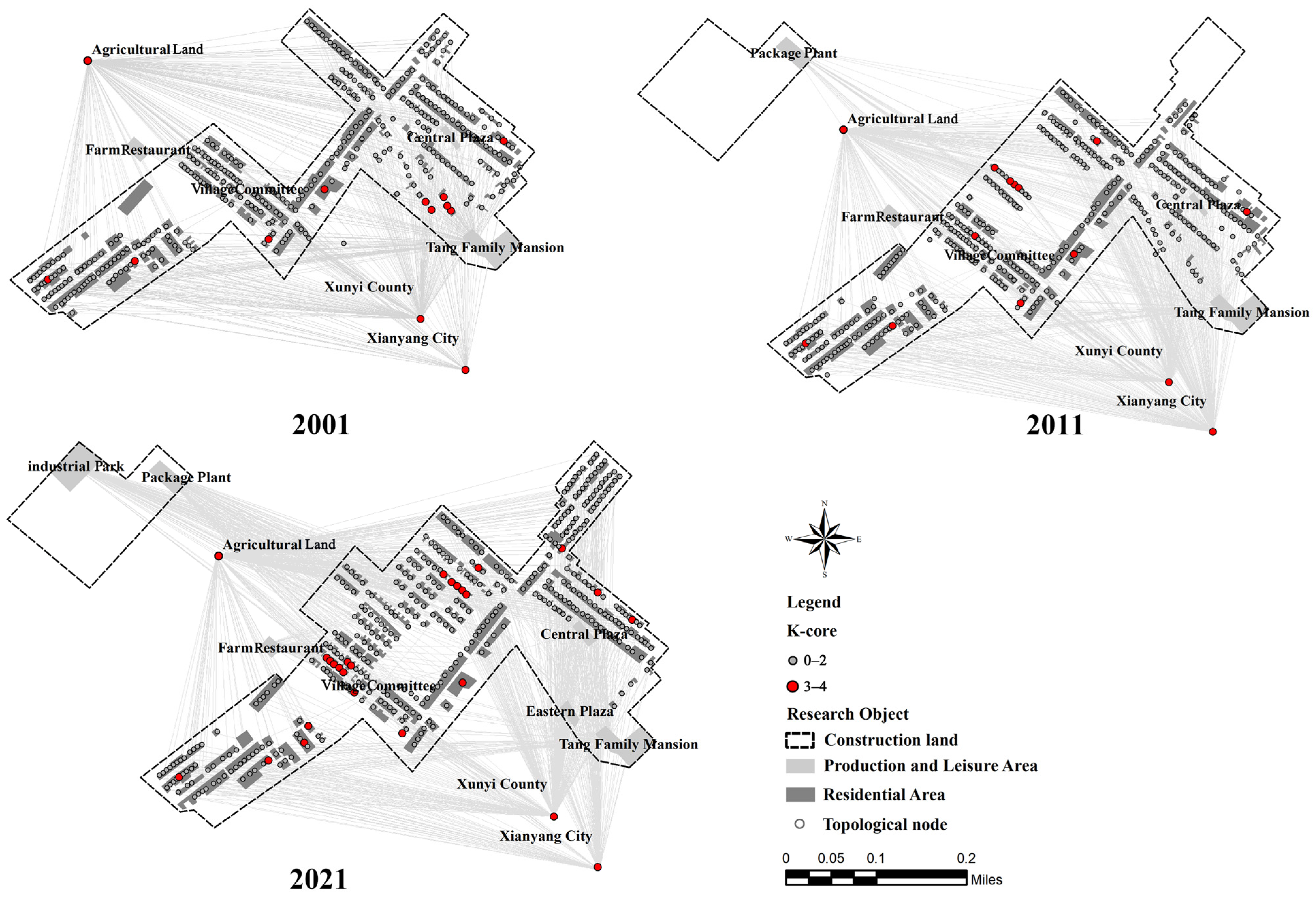Study on Spatial Adaptability of Tangjia Village in the Weibei Loess Plateau Gully Region Based on Diverse Social Relationships
Abstract
1. Introduction
2. Spatial Adaptability Research Framework
3. Materials and Methods
3.1. Typicality Analysis of Case Village
3.2. Data Source
3.3. Data Processing
3.4. Research Methods
3.4.1. Topological Simulation
3.4.2. Adaptability Evaluation Indicator System
- Integrity
- 2.
- Stability
- 3.
- Resilience
- 4.
- Recoverability
- 5.
- Connectivity
4. Results
4.1. Spatial Evolution Simulation
4.2. Network Evolution Characteristics
4.3. Spatial Adaptability Prediction
5. Discussion
5.1. Village System Adaptation Evolution Path Identification
5.2. Spatial Adaptation Evolution Mechanism Under Social Reconstruction
5.3. Adaptive Planning Response Under Subjective Behavior Simulation
6. Conclusions and Prospects
Author Contributions
Funding
Data Availability Statement
Conflicts of Interest
References
- Boussaa, D. The Past as a Catalyst for Cultural Sustainability in Historic Cities; the Case of Doha, Qatar. Int. J. Herit. Stud. 2021, 27, 470–486. [Google Scholar] [CrossRef]
- Halamska, M.; Stanny, M. Temporal and Spatial Diversification of Rural Social Structure: The Case of Poland. Sociol. Rural. 2021, 61, 578–601. [Google Scholar] [CrossRef]
- Ye, W.; Wang, Y.; Wu, K.; Yang, X.; Yang, Q.; Liu, Q. Exploring the rural transformation of the Loess Plateau from a perspective of community resilience: A case study from the Jiaxian County, northwestern China. Appl. Geogr. 2023, 154, 102919. [Google Scholar] [CrossRef]
- Akhtaruzzaman, A.; Khanam, Y.; Rahman, M.S.; Hossen Saikat, S.; Islam, M.T. Resilience of Space: Application of Text Driven Emotion in Urban Planning. Int. J. Innov. Sci. Res. Technol. IJISRT 2024, 1120–1155. [Google Scholar] [CrossRef]
- Hongyan, L.; Chongfang, J.; Tao, Z. Analysis on the Traditional Villages Development Methods in Gully Areas of Weibei Loess Plateau: Reflections Based on Fieldwork in Villages of Changwu, Shanxi Province. Huazhong Archit. 2014, 32, 107–112. [Google Scholar]
- Qingqing, Y.; Xinjun, Y.; Yanhui, G. Change in Vulnerability of Rural Human Settlement in the Semi-Arid Area of the Loess Plateau Since 1980: A Case Study of Jiaxian County, Shaanxi Province. Available online: https://www.progressingeography.com/CN/10.18306/dlkxjz.2019.05.012 (accessed on 16 November 2024).
- Wang, F.; Xu, H.; He, P.; Xue, P.; Gao, X. Adaptive Changes in Traditional Settlements in the Loess Plateau of the Yellow River Basin over 500 Years. River 2023, 2, 186–196. [Google Scholar] [CrossRef]
- Miaomiao, L.; Zhendong, L.; Ya, G. Spatial Governance of Rural Watershed in Loess Gully Region under the Background of High-Quality Development: Target, Dilemma and Realization Path. Mod. Urban Res. 2023, 12, 9–16. [Google Scholar]
- Zhang, T.; Hu, Q.; Fukuda, H.; Zhou, D. The Evaluation Method of Gully Village’s Ecological Sustainable Development in the Gully Regions of Loess Plateau. J. Build. Constr. Plan. Res. 2016, 4, 1. [Google Scholar] [CrossRef]
- Zhanhui, F.U.; Yahan, Y.; Jiajun, Q.; Xiaoyong, Z.H.U.; Xiaojun, J. Rural Hollowing out in the Yellow River Basin and the Development Path of Rural Revitalization. Prog. Geogr. 2024, 43, 1049–1059. [Google Scholar] [CrossRef]
- Chen, X.; Xie, W.; Li, H. The Spatial Evolution Process, Characteristics and Driving Factors of Traditional Villages from the Perspective of the Cultural Ecosystem: A Case Study of Chengkan Village. Habitat Int. 2020, 104, 102250. [Google Scholar] [CrossRef]
- Kong, X.; Liu, D.; Tian, Y.; Liu, Y. Multi-Objective Spatial Reconstruction of Rural Settlements Considering Intervillage Social Connections. J. Rural Stud. 2021, 84, 254–264. [Google Scholar] [CrossRef]
- Yin, J.; Wang, D.; Li, H. Spatial Optimization of Rural Settlements in Ecologically Fragile Regions: Insights from a Social-Ecological System. Habitat Int. 2023, 138, 102854. [Google Scholar] [CrossRef]
- Tong, D.; Sun, Y.; Tang, J.; Luo, Z.; Lu, J.; Liu, X. Modeling the Interaction of Internal and External Systems of Rural Settlements: The Case of Guangdong, China. Land Use Policy 2023, 132, 106830. [Google Scholar] [CrossRef]
- Long, X.; Yang, P.; Su, Q. On the Effective Organization of Rural Settlements Spatial Structure under the Transformation and Development of Mountainous Areas in Western China: Evaluation Measurement Based on Complex Adaptability Theory. Environ. Sci. Pollut. Res. 2023, 30, 89945–89963. [Google Scholar] [CrossRef]
- Walker, B.; Holling, C.S.; Carpenter, S.; Kinzig, A. Resilience, Adaptability and Transformability in Social–Ecological Systems. Ecol. Soc. 2004, 9, 5. [Google Scholar] [CrossRef]
- Folke, C.; Gunderson, L. Resilience and Global Sustainability. Ecol. Soc. 2010, 15, 43. [Google Scholar] [CrossRef]
- Batty, M. The-New-Science-of-Cities; MIT Press: Cambridge, MA, USA, 2013. [Google Scholar]
- Lyu, W.; Zhao, L. A Spatial Connection Aware Complex Network Model for Real-World Social Networks. In Proceedings of the 2023 11th International Conference on Information Technology: IoT and Smart City, Kyoto, Japan, 14–17 December 2023; Association for Computing Machinery: New York, NY, USA, 2024; pp. 155–160. [Google Scholar]
- Kenley, E.C.; Cho, Y.-R. Entropy-Based Graph Clustering: Application to Biological and Social Networks. In Proceedings of the 2011 IEEE 11th International Conference on Data Mining, Vancouver, BC, Canada, 11 December 2011; pp. 1116–1121. [Google Scholar]
- Wang, G.; Liu, S. Adaptability Evaluation of Historic Buildings as an Approach to Propose Adaptive Reuse Strategies Based on Complex Adaptive System Theory. J. Cult. Herit. 2021, 52, 134–145. [Google Scholar] [CrossRef]
- Zhao, X.; Xiang, H.; Zhao, F. Measurement and Spatial Differentiation of Farmers’ Livelihood Resilience Under the COVID-19 Epidemic Outbreak in Rural China. Soc. Indic. Res. 2023, 166, 239–267. [Google Scholar] [CrossRef]
- Mu, X.; Fang, C.; Yang, Z. Spatio-Temporal Evolution and Dynamic Simulation of the Urban Resilience of Beijing-Tianjin-Hebei Urban Agglomeration. J. Geogr. Sci. 2022, 32, 1766–1790. [Google Scholar] [CrossRef]
- Holimalala, R.; Julien, S.; Thierry, R.; Aina, A.; Rija, R.; Pierre, L.; Mahefasoa, R. The Role of Social Links on Community Resilience and Development: The Case of Ambaro-Bekibo, Vatovavy Fitovinany Administrative Region—Madagascar. Int. J. Appl. Sci. Eng. Rev. 2021, 2, 124–150. [Google Scholar] [CrossRef]
- Yu, H.; Du, S.; Zhang, J.; Chen, J. Spatial Evolution and Multi-Scenario Simulation of Rural “Production–Ecological–Living” Space: A Case Study for Beijing, China. Sustainability 2023, 15, 1844. [Google Scholar] [CrossRef]
- Borgatti, S.P.; Mehra, A.; Brass, D.J.; Labianca, G. Network Analysis in the Social Sciences. Science 2009, 323, 892–895. [Google Scholar] [CrossRef]
- Gamsu, S.; Donnelly, M. Social Network Analysis Methods and the Geography of Education: Regional Divides and Elite Circuits in the School to University Transition in the UK. Tijdschr. Voor Econ. Sociale Geografie 2021, 112, 370–386. [Google Scholar] [CrossRef]
- Anderson, T.; Dragićević, S. Complex Spatial Networks: Theory and Geospatial Applications. Geogr. Compass 2020, 14, e12502. [Google Scholar] [CrossRef]
- Onnela, J.-P.; Arbesman, S.; González, M.C.; Barabási, A.-L.; Christakis, N.A. Geographic Constraints on Social Network Groups. PLoS ONE 2011, 6, e16939. [Google Scholar] [CrossRef]
- Pilisuk, M.; Froland, C. Kinship, Social Networks, Social Support and Health. Soc. Sci. Med. Part B Med. Anthropol. 1978, 12, 273–280. [Google Scholar] [CrossRef]
- Alexander, R. Spatialising Careership: Towards a Spatio-Relational Model of Career Development. Br. J. Sociol. Educ. 2023, 44, 291–311. [Google Scholar] [CrossRef]
- Morone, P.; Sisto, R.; Taylor, R. Knowledge Diffusion and Geographical Proximity: A Multi-Relational Networks Approach. Open Agric. 2019, 4, 129–138. [Google Scholar] [CrossRef]
- Çolak, S.; Schneider, C.M.; Wang, P.; González, M.C. On the Role of Spatial Dynamics and Topology on Network Flows. New J. Phys. 2013, 15, 113037. [Google Scholar] [CrossRef]
- Miao, C.; Wang, J.; Zhuang, S.; An, C. A Coordinated View of Cyberspace. arXiv 2019, arXiv:1910.09787. [Google Scholar]
- Xia, Y.; Fan, J.; Hill, D. Cascading Failure in Watts–Strogatz Small-World Networks. Phys. A Stat. Mech. Its Appl. 2010, 389, 1281–1285. [Google Scholar] [CrossRef]
- Fang, X. Modeling and Analysis of Cascading Failure in Directed Complex Networks. Saf. Sci. 2014, 65, 1–9. [Google Scholar] [CrossRef]
- Zhou, J.; Jiang, Y.; Niu, S.; Li, L.; Li, W.; Zhang, Y.; Liu, D. Spatial Optimization of Rural Settlements in a Small Watershed Based on Social Network Analysis. Netw. Spat. Econ. 2023, 23, 799–823. [Google Scholar] [CrossRef]
- Wu, C.; Yang, M.; Zhang, H.; Yu, Y. Spatial Structure and Evolution of Territorial Function of Rural Areas at Cultural Heritage Sites from the Perspective of Social Space. Land 2023, 12, 1067. [Google Scholar] [CrossRef]
- Brunetta, G.; Ceravolo, R.; Barbieri, C.A.; Borghini, A.; De Carlo, F.; Mela, A.; Beltramo, S.; Longhi, A.; De Lucia, G.; Ferraris, S.; et al. Territorial Resilience: Toward a Proactive Meaning for Spatial Planning. Sustainability 2019, 11, 2286. [Google Scholar] [CrossRef]
- Scazzieri, R. Decomposability and Relative Invariance: The Structural Approach to Network Complexity and Resilience. Netw. Spat. Econ. 2022, 22, 635–657. [Google Scholar] [CrossRef]
- Liu, R.; Zhang, L.; Tang, Y.; Jiang, Y. Understanding and Evaluating the Resilience of Rural Human Settlements with a Social-Ecological System Framework: The Case of Chongqing Municipality, China. Land Use Policy 2024, 136, 106966. [Google Scholar] [CrossRef]
- Zhang, Y.; Yang, Y.; Wei, S.; Ma, Z.; Tian, M.; Sun, M.; Nie, J. Research on Spatial Structure and Resilience of Complex Urban Network: A Case Study of Jing-Jin-Ji Urban Agglomeration. Front. Environ. Sci. 2022, 10, 999124. [Google Scholar] [CrossRef]
- Fabbricatti, K.; Boissenin, L.; Citoni, M. Heritage Community Resilience: Towards New Approaches for Urban Resilience and Sustainability. City Territ. Archit. 2020, 7, 17. [Google Scholar] [CrossRef]
- Liu, Y.; Cao, L.; Yang, D.; Anderson, B.C. How Social Capital Influences Community Resilience Management Development. Environ. Sci. Policy 2022, 136, 642–651. [Google Scholar] [CrossRef]
- Zhang, L.; Huang, Q.; He, C.; Yue, H.; Zhao, Q. Assessing the Dynamics of Sustainability for Social-Ecological Systems Based on the Adaptive Cycle Framework: A Case Study in the Beijing-Tianjin-Hebei Urban Agglomeration. Sustain. Cities Soc. 2021, 70, 102899. [Google Scholar] [CrossRef]
- Qu, M.; Cheer, J.M. Community Art Festivals and Sustainable Rural Revitalisation. J. Sustain. Tour. 2021, 29, 1756–1775. [Google Scholar] [CrossRef]
- Li, B.; Wang, J.; Jin, Y. Spatial Distribution Characteristics of Traditional Villages and Influence Factors Thereof in Hilly and Gully Areas of Northern Shaanxi. Sustainability 2022, 14, 15327. [Google Scholar] [CrossRef]








| Village Name | Year | Number of Nodes | Network Element Category | Network Element Content |
|---|---|---|---|---|
| Tangjia Village | 2001 | 342 | Kinship | Household points |
| 348 | Occupational ties | Household points, farmland, commercial spaces, village committee, historical buildings, Xunyi County, Xianyang City | ||
| 346 | Geographical ties | Household points, historical buildings, entertainment spaces, Xunyi County | ||
| 2011 | 375 | Kinship | Household points | |
| 382 | Occupational ties | Household points, farmland, commercial spaces, village committee, historical buildings, Xunyi County, Xianyang City | ||
| 379 | Geographical ties | Household points, historical buildings, entertainment spaces, Xunyi County | ||
| 2021 | 402 | Kinship | Household points | |
| 410 | Occupational ties | Household points, farmland, commercial spaces, village committee, historical buildings, factories, industrial parks, Xunyi County, Xianyang City | ||
| 408 | Geographical ties | Household points, historical buildings, entertainment spaces, industrial parks, Xunyi County |
| Network Category | Year | Network Density | Count of Central Nodes | Maximum K-Core Ratio |
|---|---|---|---|---|
| Kinship | 2001 | 0.0663 | 4 | 0.108 (72-core) |
| 2011 | 0.0317 | 32 | 0.056 (40-core) | |
| 2021 | 0.0124 | 0 | 0.097 (8-core) | |
| Occupational ties | 2001 | 0.0059 | 6 | 0.046 (4-core) |
| 2011 | 0.0053 | 6 | 0.047 (4-core) | |
| 2021 | 0.0051 | 71 | 0.076 (4-core) | |
| Geographical ties | 2001 | 0.0026 | 17 | 0.011 (4-core) |
| 2011 | 0.0064 | 116 | 0.340 (4-core) | |
| 2021 | 0.0075 | 15 | 0.041 (8-core) |
Disclaimer/Publisher’s Note: The statements, opinions and data contained in all publications are solely those of the individual author(s) and contributor(s) and not of MDPI and/or the editor(s). MDPI and/or the editor(s) disclaim responsibility for any injury to people or property resulting from any ideas, methods, instructions or products referred to in the content. |
© 2025 by the authors. Licensee MDPI, Basel, Switzerland. This article is an open access article distributed under the terms and conditions of the Creative Commons Attribution (CC BY) license (https://creativecommons.org/licenses/by/4.0/).
Share and Cite
He, Q.; Zhang, G.; Zhou, J.; Zhao, X.; Dong, R.; Hou, Q. Study on Spatial Adaptability of Tangjia Village in the Weibei Loess Plateau Gully Region Based on Diverse Social Relationships. Land 2025, 14, 1290. https://doi.org/10.3390/land14061290
He Q, Zhang G, Zhou J, Zhao X, Dong R, Hou Q. Study on Spatial Adaptability of Tangjia Village in the Weibei Loess Plateau Gully Region Based on Diverse Social Relationships. Land. 2025; 14(6):1290. https://doi.org/10.3390/land14061290
Chicago/Turabian StyleHe, Qin, Guochen Zhang, Jizhe Zhou, Xintong Zhao, Ruiqi Dong, and Quanhua Hou. 2025. "Study on Spatial Adaptability of Tangjia Village in the Weibei Loess Plateau Gully Region Based on Diverse Social Relationships" Land 14, no. 6: 1290. https://doi.org/10.3390/land14061290
APA StyleHe, Q., Zhang, G., Zhou, J., Zhao, X., Dong, R., & Hou, Q. (2025). Study on Spatial Adaptability of Tangjia Village in the Weibei Loess Plateau Gully Region Based on Diverse Social Relationships. Land, 14(6), 1290. https://doi.org/10.3390/land14061290





